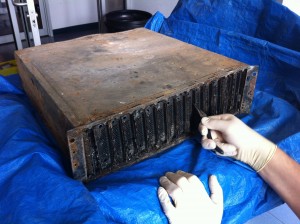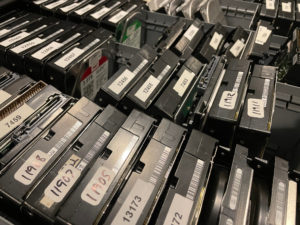
Our engineer removing a hard drive from a fire-damaged RAID.
The average turnaround time for data recovery can range from a few hours to several weeks. We realize that’s a large range — but there are quite a few factors at play, particularly when working with complex scenarios.
We start every case with a detailed, risk-free evaluation, which provides our clients with a firm price quote and a turnaround estimate. All of our data recovery services are supported by a no data, no charge guarantee: If data isn’t recoverable, there’s no charge for the attempt.
Below, we’ll break down the five factors our engineers assess to determine how long a case will take. To set up a free evaluation, get started online or call 1-800-237-4200 to speak with an expert.
1. Nature and Complexity of the Failure
The single most significant factor is the type of failure and its severity. We must determine what went wrong and how extensive the damage is.
Logical failures are software-level issues. The hardware is physically working, but the data isn’t accessible for another reason.
Simple logical cases might involve accidental deletion or a quick format. Depending on the file system and the size of the files in question, this can often be the fastest type of recovery.
On the other hand, a case involving severe file system corruption, a damaged database, a failed virtual machine, or a complex, partially-overwritten file can be extremely time-consuming. Reconstructing the lost data could take days.
Physical failures are hardware-level problems where a component has failed. Again, the extent of the failure can vary; some drives with printed circuit board (PCB) issues may be treated within a day, while complex physical failures (such as hard drive head crashes and chip-off flash data recovery) would require a multi-day process.
There aren’t strict rules, but physical failures almost always add to the timeline because they require a hands-on lab process before the logical recovery (the imaging and file system rebuilding) can begin.
2. Storage Device Type
On this blog, we focus on hard drives a lot for a good reason — hard drive data recovery remains relatively common, even as solid-state drives (SSD) have become the standard for personal computing.
With that said, the type of storage device will certainly influence turnaround times:
- Hard Disk Drives (HDDs): If a part fails, the primary challenge is finding a donor and swapping the part in a cleanroom. Safely imaging the drive can also take hours (or in extreme cases, days), but sourcing parts is the biggest bottleneck.
- Solid-State Drives (SSDs) & Flash Drives: SSDs have no moving parts, but they’re complex in other ways: They use advanced controllers, wear-leveling algorithms, and TRIM commands (which can permanently erase deleted data). Put simply, they’re not “easier” than hard drives, and physical damage can certainly add to the timeframe for recovery.
- RAID Arrays: A RAID (Redundant Array of Inexpensive/Independent Disks) combines multiple drives. For a successful recovery, we must first stabilize and image each individual drive in the array, and then mathematically rebuild the stripe and virtual volume. Learn more about RAID data recovery.
- Phones & Tablets: Modern mobile devices use file-based encryption by default. A simple broken screen is one thing (in fact, it’s simple enough that you can probably work with a local repair shop). However, more complex issues may require advanced micro-soldering and chip-level work just to gain access.
3. Availability of Specialized Parts
We’ve alluded to this already, but: For many physical failures, we need to source replacement components. That’s not always easy.
For HDDs, this means finding a compatible donor drive to source a head stack assembly or PCB. Finding this match takes time due to the strict tolerances involved; a compatible donor must often match the model, part number, firmware, and even the manufacturing site code.

A drawer full of donor hard drives in Datarecovery.com’s parts inventory.
For SSDs or flash drives, parts sourcing might mean sourcing a matching controller chip or a donor board to perform a complex chip-off procedure. Parts issues are less likely to hold up an SSD data recovery case, but it’s still a concern in certain instances.
We maintain a massive inventory of tens of thousands of donor drives and components to speed up this process. If we have the part in stock, the recovery proceeds quickly — and we invest heavily in the industry’s most comprehensive parts library to make sure that we’re prepared for each case.
4. Device Capacity and Media Condition
Once we’ve repaired physical media issues, the imaging (cloning) phase begins. We create a complete, byte-for-byte copy of your device. The device’s capacity and health directly impact this timeline in a few ways:
- Device Capacity: A 16TB server array will naturally take much longer to image than a 500GB laptop drive.
- Media Condition: A healthy device images relatively quickly. A device with many bad sectors (on an HDD) or failing memory blocks (on an SSD) can slow the process dramatically. Our equipment is designed to carefully retry bad sectors, slowing down to read weak areas, which can turn a 1-day imaging job into a 5-day job. There’s no way to speed up this process safely — it’s imperative that we work from a clone of the device rather than with the original media. Without a clone, any recovery attempt could result in permanent data loss.
5. Encryption
Encryption is a critical security feature, but it adds a necessary step to the recovery process.
- Standard Encryption: Full-disk encryption (like BitLocker or FileVault) is straightforward. After the device is imaged, we must use the password or recovery key you provide to decrypt the entire volume before we can verify the integrity of the recovered files.
- Complex Cases: If the encryption key itself is lost or corrupted, or if the failure involves a damaged TPM chip (Trusted Platform Module) on a motherboard, the recovery becomes much more complex.
It’s important to note that some forms of encryption are effectively perfect (at least, until quantum computers take a big step forward). We cannot “get around” high-level encryption; we’ll need at least a large portion of the key for recovery to proceed.
Get a Turnaround Estimate for Data Recovery
It’s impossible to quote a recovery time without seeing the device. A dead drive could be a 2-day fix or a 2-week parts-search-and-recovery effort. Just as you wouldn’t expect a mechanic to provide a quote over the phone, you should be wary of data recovery providers that promise “flat rates” or strict turnaround times.
With that said, we’ve worked to keep turnaround times as low as possible. Through investments in research, proprietary tools, and our industry-leading parts library, we’re able to treat data loss disasters quickly — even when the case involves old or obsolete media.
When we receive your device, our engineers perform a full diagnostic to identify the exact point of failure. From there, we can give you a concrete timeline and a firm price quote.
Submit a ticket online or call us at 1-800-237-4200 to speak with a recovery specialist.





